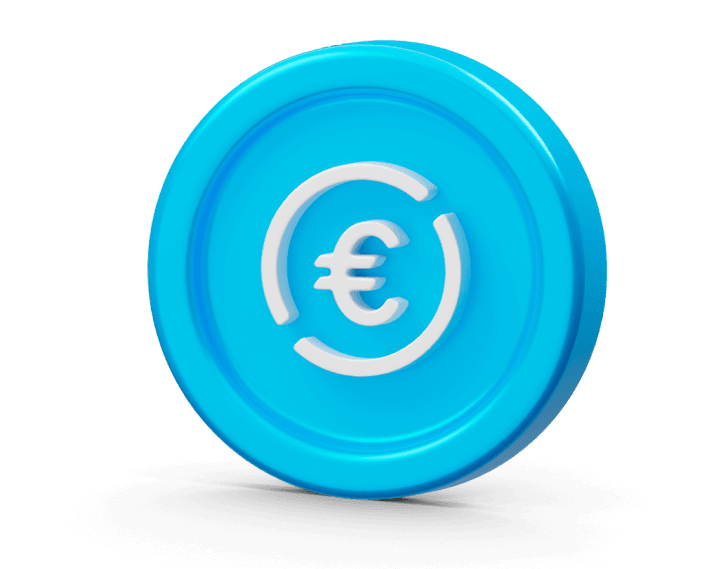Euro Stablecoin on Avalanche
Euro Stablecoin on Avalanche refers to a stablecoin that is pegged to the value of the Euro and operates on the Avalanche blockchain network. A stablecoin is a type of cryptocurrency designed to maintain a stable value by being pegged to a specific asset or currency, in this case, the Euro. The Euro Stablecoin on Avalanche provides users with the ability to transact and store digital assets that maintain a value equivalent to the Euro, offering stability and mitigating the volatility often associated with other cryptocurrencies.
By leveraging the Avalanche blockchain, the Euro Stablecoin benefits from its fast transaction speeds, low fees, and scalability, providing an efficient and secure platform for users to engage in Euro-denominated transactions within the decentralized finance (DeFi) ecosystem. The Euro Stablecoin on Avalanche aims to bridge the traditional financial world with the decentralized digital economy by offering a reliable and accessible digital representation of the Euro currency.
The methodology used to analyze the Euro Stablecoin on Avalanche dashboard involved several key steps. Firstly, relevant data was collected from various sources related to the Euro Stablecoin ecosystem. Next, a visually intuitive dashboard and visualizations. Graphs such as daily EUROC transfers, daily transfers, EUROC minted and burnt, evolution of EUROC supply, EUROC holders, distribution of holders, swaps by type, users by type, volume swapped by type, and average volume by type were analyzed to identify trends and patterns.
Based on the analysis of the daily EUROC transfers graph, it can be observed that in March, there are transfers reaching a value of 4. Towards the end of May, there are also some transfers occurring. Overall, there is a very stable trend in the transfers, with consistent values.
Moving on to the daily transfers graph, the figures range between 1 and 2. Therefore, this indicates a highly stable trend with a relatively low number of transfers. The graph does not show a significant variation in the number of transfers over time.
Examining the EUROC minted and burnt graph, it is apparent that the minted volume exceeds the burnt volume. Towards the end of May, the net volume experiences a radical increase, reaching almost 1 million units. This is mainly due to the minted volume also reaching the 1 million mark.
Finally, in the evolution of EUROC supply graph, there is a significant surge towards the end of May, surpassing the 1.5 million mark. Specifically, the current supply is recorded at 1.56 million units. This indicates a substantial growth in the supply of EUROC.
In the EUROC holders graph, it is evident that there is a total of 121 users holding EUROC.
Examining the distribution of holders, the most prominent category is the one with <10 EUROC, comprising 66 users. Following closely behind is the group of holders with 100-1k EUROC, which consists of 21 individuals.
In the swaps by type graph, it is evident that both inflow and outflow have been increasing over the past few days. These two types of swaps show very similar figures, indicating a balanced exchange of assets.
Analyzing the users by type graph, we can observe that inflow has been predominant in the recent days. However, during the last day, there has been a radical increase in both inflow and outflow, with the number of users remaining the same. This suggests a significant shift in the trading activity of users.
Turning to the volume swapped by type graph, it is apparent that the outflow has experienced a substantial surge, reaching 300k units. The inflow volume also plays an important role, nearly reaching 200k units. This indicates a considerable amount of assets being transferred out as well as new assets flowing into the system.
Finally, in the average volume by type graph, the outflow has been predominant throughout the analyzed period. However, during the last day, there has been a decrease in outflow volume, accompanied by an increase in inflow volume. This suggests a shift in the average amount of assets being exchanged between users, with a higher average inflow volume and a lower average outflow volume.
1- The daily EUROC transfers show a stable trend with occasional spikes, indicating consistent activity over time.
2- The daily transfers exhibit a highly stable trend with a relatively low number of transactions, suggesting limited transfer activity.
3- The EUROC minted and burnt graph reveals a higher minted volume compared to the burnt volume, resulting in a significant increase in net volume towards the end of May.
4- The evolution of EUROC supply demonstrates a remarkable surge towards the end of May, surpassing 1.5M, indicating substantial growth in the overall supply.
5- The EUROC holders graph shows a total of 121 users holding EUROC, reflecting the number of participants in the ecosystem.
6- The distribution of holders highlights the dominance of users with <10 EUROC holdings (66 users), followed by the 100-1k EUROC range (21 holders).
7- Swaps by type depict increasing inflow and outflow over the recent days, with similar figures, indicating a balanced exchange of assets.
8- Users by type show a predominance of inflow, but there has been a radical increase in both inflow and outflow users during the last day, suggesting significant changes in trading activity.


In the left table, we can observe the EUROC holders. On the left side, we see the wallets and their total flow. Notably, the first six wallets have more than 45k units, indicating significant holdings.
However, starting from the seventh wallet and onwards, the total flow decreases to less than 20k units. This suggests a concentration of EUROC holdings among a few prominent wallets, while the majority of wallets hold relatively smaller amounts.